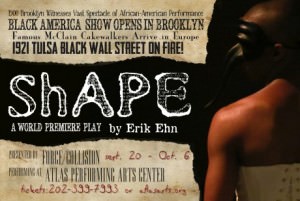In Part Two of Taking SHAPE actors Frank Britton and Dane Figueroa Edidi introduce us to their characters Billy and Cordelia McClain.

From Frank Britton (Billy McClain):
When my journey with SHAPE began, I was truly surprised at my lack of knowledge of Billy and Cordelia McClain, and of the Tulsa Race Riots. Given that not too much is known about them (even though there is a little more on Billy than Cordelia). Even though I had already known quite a bit about African-American entertainers during this time period, and the struggles they endured, I still felt like I was deprived of something. I had never even known that a dark moment in American history such as the Tulsa Race Riots had taken place.
In the weeks and months since April 30th of this year (when work on SHAPE began), I continue to be amazed at what I’ve missed, historically speaking: Black America, another event of which I was unaware, was such a mammoth undertaking, that I could only begin to even wonder how everything was pulled off. Today, such an event is more than possible, but in those times, detail and intricacy was everything; Billy McClain, who was very much a renaissance man (lawyer, prizefighter, producer, and entertainer, to name a few), seemed to be someone who was very much in control of his life, and very much in control of who he was. He was a taker, an opportunist, highly intelligent, and quite bold–traveling around decked out in diamonds, something that was unheard of during those times, especially for African-Americans. I was stunned to have had brought to my attention at one point that Billy was abusive to Cordelia, but no one knows the level of tumult that was in the marriage. Furthermore, during more research, I learned that, according to Billy’s own words, he was a personal masseur to a chapter of the Ku Klux Klan, even learning their codes and passwords. I don’t know how accurate this is, but given that these were reportedly his words in a letter to an acquaintance, I have to take it at face value.
To say that this experience has been challenging would be an understatement. Erik’s plays are painstakingly researched, which results in a level of density that makes the process even more adventurous. On paper, the script is about 24 pages, but there is so much in there. I have left rehearsals with headaches occasionally because of literally thinking too hard, trying to wrap my head around the poetry of the play, attempting to crack the proverbial nut that is SHAPE. Of course, an actor strives to achieve clarity and understanding in their text in whatever play they work on, but I think with this play in particular, the more I surrender myself over to the text, clarity and understanding is discovered as time rolls on, and this is because of the style in which the play is written, and with John’s guidance. Erik definitely has his own distinct voice. I do the same whenever I tackle Shakespeare– scanning every line of text, making sure that you know your objectives and understand exactly what you’re saying, but also not resisting the text. Mining this script is a daily task. I believe that right up until November 18th, which is my final day with SHAPE, there will still be more to be unearthed.
This is an important story. The McClains have been more or less forgotten, and the Tulsa Race Riots were buried in history until only recently. I’m proud to be part of a play that sheds some light on both.
Frank’s Playlist (Music that inspires him for his process on SHAPE)
~”Consolation,” composed by Elliot Goldenthal, from the score to the motion picture A Time to Kill (1996).
~”Georgia Peach Rag,” composed by Elliot Goldenthal, from the score to the motion picture Cobb (1994).
~”Opening Credits,” composed by Terence Blanchard, from the score to the motion picture Malcolm X (1992).
~”Defend Brooklyn,” composed by Terence Blanchard, from the score to the motion picture Inside Man (2006).
~”Empty Chambers/ Romeo is Dreaming,” composed by Mark Isham, from the score to the motion picture Romeo Is Bleeding (1993).

Dane Figueroa Edidi (Cordelia McClain):
If I were to write the headline for my blog it would read as such… The Lady Behind the Woman: Lady Dane speaks about finding Madame Cordelia. I digress; let me begin with a story… The night was cold and I wasn’t all alone but it sure felt heavy, heavy, honey. I had just returned from New York to DC from an audition. My body was spent from living half the week in New York and half the week in Baltimore while commuting to DC to tend to my sister’s and my tea shop, Sitea. New York was good to me the previous year; I did a fun show at theatre for the New City in which I played the Orisha Elegua, made my New York cabaret debut at Don’t Tell Mama. Still despite all that, I continued to have difficulty in transitioning to New York.
One night, John called me from Texas, excitement in his voice, I knew this voice, a new work had lit a fire in him. He recounted his conversation with Erik and asked me to read the script: Now, I was vaguely familiar with Billy McClain… “Wasn’t that the man in that Shirley Temple movie… yeah the one who played the butler,” I said with a knowing nod, but Cordelia McClain was a mystery. Thank the stars for Google…. But… the curios thing about Ms. McClain is there is not much information about her. Where you can find oodles of knowledge dripping from the pores of history on her male counterpart/husband Billy, it is almost as if Cordelia was lost through the pages of time. I read the script, not putting it down for one second and realized tears were streaming from my eyes. I felt a connection with her, my blood spoke her name and my skin raised when I whispered the text. John then broke some of the most amazing news I had heard in some time – I would be playing Cordelia and the tears started their stream anew.
Then there’s the question: who is Cordelia McClain? In the play she is clearly defined, a magical fey woman in love with a powerful man, she can bewilder even the most hardened hearts. Her husband, powerful as he may be, is powerless without her for she is a woman who sees into the hearts of the audience. She is a woman who can “shape shift” into the thing they wish and yet a woman who despises them for wishing it; and a performer who eventually wants nothing more than to be seen and respected as an artist.
In the play it is clear who she is but I think that plays are not just the psyche of the playwright made manifest but also the collective truth of “actual experience”. I could not simply rely on the play to create Cordelia for me, history had to give something and so I decided to look into the stories of others who may or may not have influenced her. I looked to Josephine Baker- captive nightingale fighting to be heard, Billie Holiday – a black siren stolen by circumstance, Bessie Smith – moaning blues dark like birth from unseen places, Pearl Bailey – gruff femininity and sturdy elegance, Sissieretta Jones (The Black Patti) – a diva who sang arias with a bewitching flair and yet died with no money at all, Aida Walker – actress and beauty fighting to portray more then “mammy” or “loose woman” and lastly Adah Menken- the sensation who played a man and always wished to be respected as a “legitimate” actress not just an entertainer.
At different moments I looked at each of these women while meditating on Cordelia to infuse her with an authentic life all her own. In the play, she is magical, she is beautiful, she is a woman, she is a fairy, she is a queen, she is a personification of versatility or should I say adaptability, a shapeshifter, a performer, a diva, a keeper of mysteries old and yet reflected narrowly through the image of a people who are not her own. She is an exotic creature who fights against extinction. When I stripped away all the glamour of divas past, looking deep into the heart of the play, I see the same thing- longing.
I found Cordelia McClain from deep within that part of myself that is connected to ancestor. I found her singing her “fairy songs” from within me.
SHAPE plays from September 20-October 6, 2012 at Atlas Performing Arts Center’s Sprenger Theatre -133 H Street, SE, in Washington, DC. Click here for tickets.
SHAPE plays in New York City from November 10-18, 2012 at La Mama ETC – 74 East 4th Street, in New York, NY.
LINKS
Here are soundbites and videos from SHAPE:
https://vimeo.com/48957873
https://vimeo.com/48929500
https://vimeo.com/46889370#
https://vimeo.com/48520324





